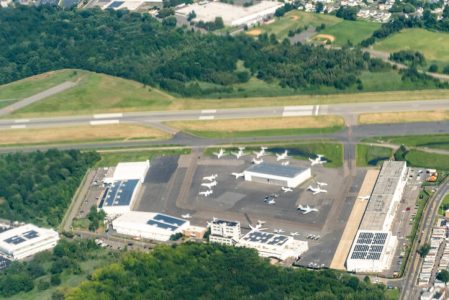Part 135 pilots take note of a shortened runway at Teterboro
Many Part 135 companies have restrictions on the minimum landing length for their fleet of aircraft, whether they have one airplane or 200 (some Part 91 operators who share the same safety practice). I like it because it takes all the guesswork out of the basic “Can we land there?” question. Obviously, someone has to do some performance calculations and add a comfortable margin, but that’s it. The number is set in stone.
Or is it? There may be some gotchas out there and you’ll only know about them if you pay attention to the Notice to Air Mission (NOTAM) system before each and every flight. Buried in all the taxiway closures and missing runway lights will be the information posted about temporary runway length changes. And some are significant and critically important.
Teterboro is the perfect current example. Runway 6/24 is normally 6013 feet long, more than enough for companies with a 5000-foot minimum runway length. But the airport just installed an engineered materials arresting system (EMAS) at the northeast end and unfortunately, some issues were discovered during an inspection by the FAA and Port Authority. And these issues are going to require a lengthy repair.
The repairs will require the airport to “administratively shorten” runway 24 by 1003 feet for takeoff. This will reduce the takeoff run available, the takeoff distance available, and will reduce the accelerated stop distance to 4,850 feet.
While this still meets the 5000-foot minimum, there’s an additional detail to note. Aircraft departing Runway 24 will be cleared for takeoff from taxiways R or V, resulting in a further decrease in available distance. But don’t worry, operations on Runway 6 are unaffected, and the landing distance for Runway 24 remains unchanged at 6013 feet.
Why We Review All Available Information Before a Flight
As pilots, our primary responsibility is the safety of our passengers and crew. Staying informed is a key part of fulfilling that duty. Here are 10 reasons why:
- Safety: Understanding the current conditions of the airport is essential for ensuring the safety of the crew and passengers. Information about runway conditions, lighting, and other factors can significantly affect landing procedures.
- Flight Planning: Reviewing airport information can aid in efficient flight planning. It can help pilots anticipate fuel requirements, calculate accurate ETAs, and plan alternate routes if necessary.
- Regulatory Compliance: NOTAMs often contain information about temporary changes to regulations, such as noise abatement procedures or restrictions on certain types of operations. Pilots must be aware of these to stay compliant.
- Equipment Availability: Information about the availability of navigation aids, ground services, and other equipment can affect both the approach and post-landing procedures.
- Weather Conditions: Airports provide updates on local weather conditions that could impact takeoff and landing. Understanding these conditions ahead of time can prevent unnecessary risks.
- Runway Status: NOTAMs often include information about runway closures or changes to runway lengths. This information is crucial for calculating takeoff and landing distances.
- Air Traffic: Information about the volume of air traffic at an airport can help pilots anticipate potential delays and make necessary adjustments to their flight plans.
- Emergency Procedures: Knowledge about the airport’s emergency procedures and facilities can be invaluable in case of an unexpected event during landing.
- Security: In today’s world, security measures can change rapidly. Being up-to-date with the latest security protocols at the intended landing airport is critical.
- Efficiency: Ultimately, having all this information at hand contributes to the overall efficiency of the flight, reducing delays, and ensuring a smoother experience for all on board.
The good news for Teterboro is that operations on runway 6 are unaffected, and the landing distance for Runway 24 will remain 6013 feet. So, stay vigilant and read those NOTAMS, especially if you are a Part 135 crew. Nobody likes surprises, especially the ones that make us instantly illegal.
RELATED READING
RELATED CTS TRAINING










